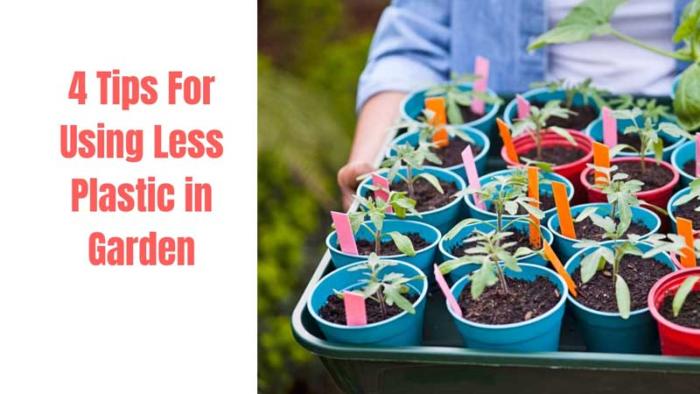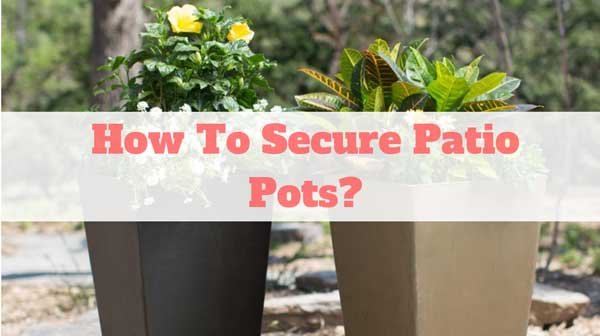
4 Amazing Tips for Using Less Plastic in Garden
In many modern gardens today, plastics are always a significant component of the garden.
These plastics can be in the form of Plat pots, bird feeders, compost bins plant labels, and even sheeting utilized in suppressing weeds.
This doesn’t stop there, most basic garden tools have plastic components, and a good example is a lawnmower.
According to research, an estimate of 500 million seed trays and Plat pots are being sold every year.
Most of these farm plastics are incinerated or sent to landfills. There are very minute recycling facilities available for these plastics, and this means just a few are recycled.

One key component of plastics during production is a significant volume of fossil fuel utilized in its creation, and these take about 500 years to decompose organically.
However,
since more information about plastics and the consequences of its single-use feature, most gardens, nurseries, and farm tool manufacturers are striving to reduce this lousy effect—by ensuring its recycling and reuse. This is quite impressive, but we can avoid the use of plastics in general.
My name is Vicki J. Stabile; I’m a gardening enthusiast. For five years I have been gardening at my backyard. Years of this practice has ensured that learned lots of things concerning gardening and it’s related aspects like home’s outdoor. So, below I give you tips and how to rely less on plastics in your garden.
Quick Navigation
1. Plastic Use Reduction

You can reduce the volume of plastics you utilize by not buying it. This isn’t a hard milestone to achieve, and it is effortlessly avoidable. There exists already non-plastics alternatives for gardening tools like plant pots etc.
Most famous is the varying materials in which biodegradable pots are manufactured from; rice husks, coconut husks, seaweed, or even wood chips.
Available in two types: there exists those that have a lifespan of a few months. These biodegradable pots are planted directly in the soil, and this ensures that they break down fast, this means that plant roots are given the room to develop through into the soil. Those manufactured from latex, rice husks, bamboo lasts for some years, and these plant pots can be deposited into the compost heap at your home when it is reasonable to do so.
Some nurseries or garden centers make use of biodegradable pots; some others, however, ask gardeners to return these plastics pots to ensure its reuse and recycling. Also, you can make use of toilet roll holders or newspapers to create your pots.
2. Tomato and Seedlings in Biodegradable Tree Pots |Alternatives To Plastic Plant Pots
To avoid unnecessary plastic waste is currently one of the issues that move people the most. If you also think about your wallet – well, all the better! Reuse instead of throwing away is the order of the day.
All hobby gardeners and flower lovers know them: the plant pots made of plastic, in which the newly purchased seedlings stuck. They are not pretty and usually end up in the bin after removing the plants. You can decide to buy these products packaged with non-plastic alternatives; that is with biodegradable materials like wood.
3. Reusing Garden Plastic Pots
Reusing these plastic garden pots can be achieved in the following ways;
Seasonal Garden
A bed can also be planted with flowers that are not winter-proof. For this, you put the flowers together with their pot in prepared, with an old plant pot. As soon as it gets cold, the “chilblains” can then be easily pulled out of the recesses and replaced by hardy specimens.
Sieve
No matter whether for grit, grass seed or fertilizer – with their holes in the ground you can use plant pots as a sieve. Of course, you should be careful with road salt – not only for animal and environment sake but also for your boots!
Versatile Implantation Aid
When planting seedlings, an empty plant pot can be equally useful in several ways. If you fill the container into which the seedling is to put soil, an empty plant pot can keep the necessary space for so long. Another plastic cup serves as a shovel. If you want to mulch the soil, you protect the small plant from being buried under the mulch by covering it with a plant pot.
4. Recycling Plastic
Plastic recycling is an ideal way to recycle already consumed resources (petroleum). And we find plastic in our everyday lives everywhere and not only in our garden plant pots. Usually, we throw it in the yellow bin and then do not worry about it. But what happens to the plastic after that? And is all the plastic recycled? The truth is, plastic recycling works just when you buy recycled products.
Plastic Recycling – How is the Plastic Separated?

In modern sorting plants, plastic fractions are separated by the use of different physical processes. A sieve drum divides the material flow into smaller and larger packages, and foils are sucked off, for example. An overhead magnet takes tinplate cans out of the stream. These are then pressed together in cubes to simplify further transport.
Near-infrared separators detect the remaining different packaging materials on the reflected light spectrum. They are captured and blown out. This works for beverage cartons as well as for various plastics, such as PET, PE, PS, PP, which can then be sorted and recycled separately.
Plastic Recycling – What Happens to the Recycled Material?
Tinplate has the best recycling rate among packaging materials. It can be processed almost indefinitely and without loss of value. The pressed cubes are heated in a steel mill, then cast and then rolled into sheets. The folded sheets are processed, for example, to cans.
Plastics such as polypropylene (PP) are first washed after they have been collected sorted, and the foreign substances removed. Then the material is either shredded to PP chips or processed into granules. Every type of plastic has its recycling process.
Just like we mentioned above, you should go for recycled products, and every city has a council which has recycled plant pots, you should also check with them.
Final Words
Plastics have come to be a daily necessity in our lives, but we shouldn’t let them destroy our world. Ensuring our gardens is plastic free might seem overstated but it can be done. However, I hope these tips I’ve provided will help you too in your garden.






